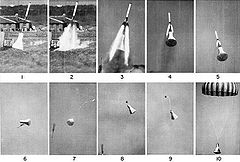
Mercury-Atlas 3
Encyclopedia

Cape Canaveral Air Force Station Launch Complex 14
Launch Complex 14 is a launch site at Cape Canaveral Air Force Station, Florida. LC-14 was used for various manned and unmanned Atlas launches, including the Friendship 7 flight aboard which John Glenn became the first American to orbit the Earth....
at Cape Canaveral
Cape Canaveral Air Force Station
Cape Canaveral Air Force Station is an installation of the United States Air Force Space Command's 45th Space Wing, headquartered at nearby Patrick Air Force Base. Located on Cape Canaveral in the state of Florida, CCAFS is the primary launch head of America's Eastern Range with four launch pads...
, Florida
Florida
Florida is a state in the southeastern United States, located on the nation's Atlantic and Gulf coasts. It is bordered to the west by the Gulf of Mexico, to the north by Alabama and Georgia and to the east by the Atlantic Ocean. With a population of 18,801,310 as measured by the 2010 census, it...
. The Mercury
Mercury program
Mercury Program might refer to:*the first successful American manned spaceflight program, Project Mercury*an American post-rock band, The Mercury Program...
capsule contained a robotic "mechanical astronaut". Mercury spacecraft No. 8 and Atlas
Atlas LV-3B
The Atlas LV-3B, Atlas D Mercury Launch Vehicle or Mercury-Atlas Launch Vehicle, was a man-rated expendable launch system used as part of the United States Project Mercury to send astronauts into low Earth orbit. It was derived from the SM-65D Atlas missile, and was a member of the Atlas family of...
No. 8 100-D were used in the mission.
The mission was terminated by the range safety officer after 43.3 seconds due to failure of the launch vehicle to follow its roll and pitch programs. Although the launch vehicle was destroyed, considerable benefit was derived from the flight test. The launch escape system saved the Mercury spacecraft from destruction. The capsule flew to an apogee of 7.2 km and downrange only 1.8 km.
The flight of the Mercury capsule lasted 7 minutes and 19 seconds, most of that time descending on its parachute. The spacecraft was recovered some 20 minutes after launch in the Atlantic Ocean and reused on the next flight (MA-4) as spacecraft No. 8A.

